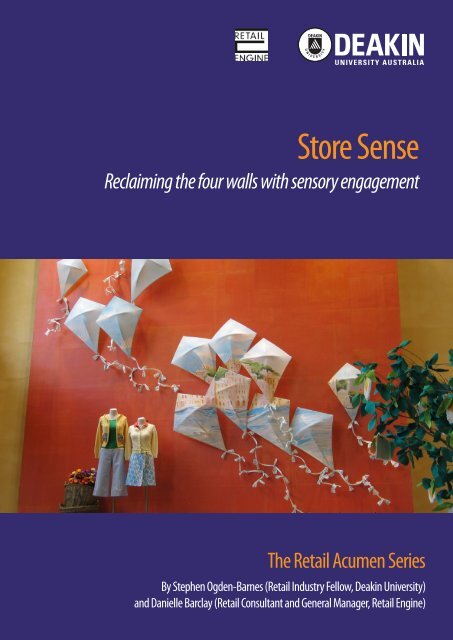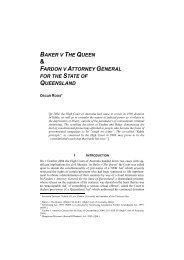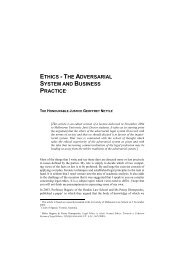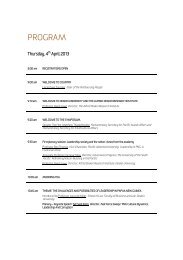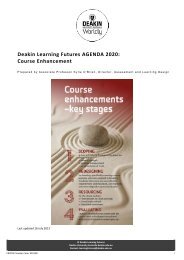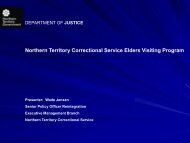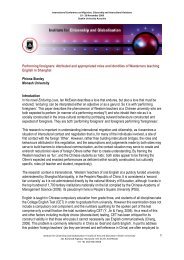Store sense: Reclaiming the four walls with - Deakin University
Store sense: Reclaiming the four walls with - Deakin University
Store sense: Reclaiming the four walls with - Deakin University
You also want an ePaper? Increase the reach of your titles
YUMPU automatically turns print PDFs into web optimized ePapers that Google loves.
<strong>Store</strong> Sense<br />
<strong>Reclaiming</strong> <strong>the</strong> <strong>four</strong> <strong>walls</strong> <strong>with</strong> sensory engagement<br />
The Retail Acumen Series<br />
By Stephen Ogden-Barnes (Retail Industry Fellow, <strong>Deakin</strong> <strong>University</strong>)<br />
and Danielle Barclay (Retail Consultant and General Manager, Retail Engine)<br />
1
Contents<br />
About <strong>the</strong> authors ................................................................................................................................................................ 4<br />
The new retail dynamic ...................................................................................................................................................... 5<br />
The physical store under threat ...................................................................................................................................... 5<br />
Opportunities to reinvent <strong>the</strong> store .............................................................................................................................. 6<br />
The brand experience ......................................................................................................................................................... 7<br />
The new consumer .............................................................................................................................................................. 7<br />
The youth market - ‘future-proofing’ <strong>the</strong> retail store ..............................................................8<br />
E-<strong>sense</strong> - how technology is connecting <strong>with</strong> <strong>the</strong> <strong>sense</strong>s in-store ..................................................................... 8<br />
Shopper marketing in perspective ................................................................................................................................ 9<br />
The sensory store .................................................................................................................................................................10<br />
A focus on <strong>the</strong> <strong>sense</strong>s .........................................................................................................................................................11<br />
Sight: <strong>the</strong> visible building block of retailing .............................................................................11<br />
Tactics and techniques ......................................................................................................................12<br />
Touch: <strong>the</strong> power of <strong>the</strong> tactile experience ..............................................................................14<br />
Tactics and techniques ......................................................................................................................15<br />
Sound: amplifying <strong>the</strong> shopping experience ...........................................................................16<br />
Tactics and techniques ......................................................................................................................17<br />
Advances in sound technologies ...................................................................................................17<br />
Scent: <strong>the</strong> most powerful <strong>sense</strong> of all .........................................................................................18<br />
Tactics and techniques ......................................................................................................................19<br />
Taste: try before you buy .................................................................................................................20<br />
Tactics and techniques ......................................................................................................................20<br />
Ambience - <strong>the</strong> ‘hidden’ features ....................................................................................................................................21<br />
The sensory store and competitive advantage .........................................................................................................21<br />
Multi-sensory engagement: 1 minute case studies ................................................................................................22<br />
Conclusion ..............................................................................................................................................................................23<br />
References ...............................................................................................................................................................................24<br />
3
About <strong>the</strong> authors<br />
Danielle Barclay is a retail entrepreneur having launched one of <strong>the</strong> newest retail technology agencies<br />
in Australia and New Zealand, Retail Engine, part of <strong>the</strong> CPM Group. Retail Engine has quickly developed<br />
a reputation as innovators in <strong>the</strong> retail space, developing leading edge solutions to traditional activities<br />
including point of sale, display, visual merchandising and product demonstrations. Their clients in<br />
Australia and New Zealand have included McDonald’s, Mercedes Benz, Lion, NZ Lotteries, Telstra, Intel,<br />
P&G and Kimberley-Clark.<br />
With a retail marketing background spanning 11 years and three continents Danielle has worked in<br />
management roles both for FMCG companies and advertising agencies giving her unique insights into<br />
<strong>the</strong> way consumers think and more importantly how <strong>the</strong>y interact <strong>with</strong> <strong>the</strong> retail environment.<br />
Steve Ogden-Barnes is retail Industry Fellow at <strong>the</strong> <strong>Deakin</strong> <strong>University</strong> Graduate School of Business.<br />
Following a diverse career in UK retailing, Steve moved to Australia to specialise in retail education,<br />
industry engagement and research. Steve has recently completed a PhD focusing on marketing<br />
decision making and sales promotion management in <strong>the</strong> Australian retail marketplace. In addition, he<br />
is supporting <strong>the</strong> development of <strong>the</strong> new Graduate Certificate of Retail Management at <strong>Deakin</strong>, due to<br />
be launched in 2012. Steve is a regular commentator on retail and consumer issues, for <strong>the</strong> Australian<br />
Financial Review, The Age, The Australian, <strong>the</strong> Herald Sun, BRW, ABC Radio and Today Tonight.<br />
4
‘Our <strong>sense</strong> of sound, sight, smell, and touch have a powerful effect on us, and psychological research is<br />
just beginning to explain some of <strong>the</strong> physical, cognitive, social and emotional effects. Sensory stimuli<br />
can influence environments, improve <strong>the</strong> shopper experience and change <strong>the</strong> nature of behaviour in ways<br />
beyond our consciousness’. [1] , p. 286.<br />
The new retail dynamic<br />
The evolution of stores and shopping in Australia is part and parcel of <strong>the</strong> story of European settlement.<br />
As far back as <strong>the</strong> 1800’s ‘going shopping’ was still a relatively new social concept although cities and<br />
towns rapidly formalised to offer residents and visitors greater leisure and retail opportunities.<br />
New settlers continued to bring <strong>the</strong>ir diverse cultural traditions <strong>with</strong> <strong>the</strong>m, buying goods from home<br />
producers, street-sellers or at <strong>the</strong> wharf or market-place. With <strong>the</strong> first purpose-built shops beginning<br />
to appear in Britain and Europe from <strong>the</strong> early nineteenth century, emergent colonial societies at <strong>the</strong><br />
outposts of <strong>the</strong> Empire quickly followed suit.<br />
For <strong>the</strong>se early consumers, <strong>the</strong> shopping experience was a special occasion - a trip to town, dressed<br />
in <strong>the</strong>ir Sunday best to marvel at <strong>the</strong> spectacles presented in shop windows, combined <strong>with</strong> <strong>the</strong><br />
anticipation of a special purchase. The nostalgic smells, sounds and emotions of <strong>the</strong>se vibrant<br />
experiences (for example corner shops <strong>with</strong> <strong>the</strong>ir tempting arrays of sweets or tins of biscuits) is still<br />
powerful and evokes memories of a time when shopping was far less complex and sophisticated but<br />
when <strong>the</strong> experience was at its most pure [2] .<br />
Since <strong>the</strong>se early beginnings and for most of subsequent retailing history, <strong>the</strong> physical bricks and<br />
mortar environment has provided both <strong>the</strong> focus and <strong>the</strong> context for customer engagement. As<br />
economies evolved, established brands in all major countries developed large retail store chains and<br />
distribution networks. Competition was based on <strong>the</strong> traditional marketing pillars of price, product,<br />
place and promotion <strong>with</strong> <strong>the</strong> scale and resources of bigger organisations providing strong competitive<br />
advantage. As time progressed, independent retailers rapidly lost ground to both <strong>the</strong> shopping centre<br />
and <strong>the</strong> national (and international) chains as consumers sought <strong>the</strong> convenience of location and <strong>the</strong><br />
confidence of <strong>the</strong> big brands.<br />
But all this is rapidly changing. The new dynamics of <strong>the</strong> global retail economy are arguably threatening<br />
traditional store environments, as shoppers increasing turn to alternative channels like <strong>the</strong> internet to<br />
browse, compare and ultimately purchase. Faced <strong>with</strong> this evolution, it is essential for bricks and mortar<br />
retailers to revisit <strong>the</strong> principles and practices of in-store consumer engagement and to understand<br />
in greater detail how <strong>the</strong>ir physical store environments can be leveraged to optimum effect to ensure<br />
sales optimisation, customer satisfaction and sustainable profitability.<br />
The physical store under threat<br />
The explosion of internet and multi-channel retailing in <strong>the</strong> last decade is having a considerable impact<br />
on <strong>the</strong> evolution of retail environments and shaping how people buy. The growth in online sales is<br />
capturing a significant and increasing share of <strong>the</strong> retail dollar, estimated by Forrester research to<br />
reach 8% of total retail sales in <strong>the</strong> US and Europe by 2014 [3] . In Australia <strong>the</strong> value of online purchases<br />
has grown at an average rate of 15% per annum since 2005, <strong>with</strong> Forrester predicting that Australian<br />
5
online retail sales will more than double from $16.9 billion in 2009 to $33.3 billion in 2015.<br />
With <strong>the</strong> ease, convenience and cost effectiveness of new technologies at <strong>the</strong>ir disposal, consumers<br />
are increasingly playing <strong>the</strong> currency markets to take advantage of lower overseas product costs, and<br />
domestic retailers are finding it difficult to compete in key commodity categories like home electronics,<br />
books and music. In addition, online retailers are using web-based technologies - for example 3D -<br />
to create virtual online environments where consumers can interact and engage <strong>with</strong> products and<br />
retailers much <strong>the</strong> same as in a physical store. O<strong>the</strong>r consumer benefits offered by online shopping<br />
includes virtual shopping carts, product comparison and recommendations based on purchase<br />
behaviour, tailored advertising and access to limitless information and reviews. Finally, for <strong>the</strong> timepressured,<br />
<strong>the</strong>re are no queues and no need to leave <strong>the</strong> comfort of home or <strong>the</strong> office. Technology<br />
enables consumers to do all this ‘on <strong>the</strong> move’ <strong>with</strong> mobile phone internet penetration reaching 50%<br />
in Australia [3] . Social media has become a critical component in <strong>the</strong> retail message mix, changing <strong>the</strong><br />
way consumers hear about products, research and acquire. Now consumers seek <strong>the</strong> opinion of o<strong>the</strong>rs<br />
in relation to <strong>the</strong>ir purchases, bypassing (or at least qualifying) <strong>the</strong> mainstream marketing messages<br />
of retailers.<br />
There is no disputing <strong>the</strong> fact that <strong>the</strong> multi-channel consumer is here to stay. With <strong>the</strong> explosion<br />
of new ‘connectivity’ between consumers, brands and channels [4] , many retailers are strategising to<br />
capitalise upon <strong>the</strong>se new market channel and dynamics, for example in evaluating <strong>the</strong> role that<br />
mobile phone applications and social media channels like Twitter and Facebook can play in relation<br />
to both sales promotion and transactions. Anticipating a very different future, some researchers have<br />
conducted focus groups <strong>with</strong> ‘avatar-shoppers’ in virtual worlds like Second Life [5] to understand <strong>the</strong><br />
similarities and differences between <strong>the</strong> truly virtual and <strong>the</strong> real world shopper. Research into virtual<br />
category management, for example in online grocery stores [6] , is also helping ambitious web retailers<br />
to identify improvement opportunities for selling products, <strong>the</strong>reby driving transactional efficiency<br />
and optimising sales. The physical bricks and mortar store, it would appear, is under increasing threat<br />
in <strong>the</strong> multi-channel age as both research agendas and media attention turns to alternative channels<br />
of research, engagement and acquisition. So is it all over for <strong>the</strong> humble shop, or can retailers work to<br />
restore <strong>the</strong> high street experience <strong>with</strong> new strategies to re-engage <strong>the</strong> shopper at <strong>the</strong> sensory level?<br />
Opportunities to reinvent <strong>the</strong> store<br />
While <strong>the</strong> significance of <strong>the</strong> internet and social media in <strong>the</strong> retail mix is not to be underestimated, <strong>the</strong><br />
very conservative recent sales growth noted in countries like Australia [7] reveal that retailers need more<br />
than ever to optimise every physical customer contact and engagement opportunity (and crucially<br />
every store visit) to drive customer numbers, sales and customer satisfaction in bricks and mortar<br />
environments. It is even more important to address some of <strong>the</strong> commonly reported negatives about<br />
<strong>the</strong> physical retail environment, for example <strong>the</strong> spatial and human crowding which affects consumer<br />
perceptions of <strong>the</strong>ir shopping experience [8, 9] . With <strong>the</strong> significant capital investment that retailers<br />
have at stake in physical retail stores, it would be short-sighted indeed to both underestimate and<br />
undervalue <strong>the</strong> significance of tactile interaction <strong>with</strong> a product and <strong>the</strong> human service interactions<br />
that can only be found in a store environment.<br />
6
The brand experience<br />
More than any o<strong>the</strong>r medium, <strong>the</strong> store offers <strong>the</strong> greatest potential for consumers to really experience<br />
<strong>the</strong> brand. Brand experience can be thought of as sensations, feelings, perceptions, and behavioural<br />
responses evoked by brand-related stimuli (Fig 1). These influence consumer satisfaction and loyalty,<br />
enabling <strong>the</strong> brand to sell products at a premium and create a powerful competitive advantage.<br />
Sound:<br />
brand soundtrack<br />
Figure 1: brand experience via <strong>the</strong> <strong>sense</strong>s<br />
The more powerful this experience, <strong>the</strong> stronger <strong>the</strong> brand impression and <strong>the</strong> retailer’s ability to<br />
create meaningful and memorable differentiation. In recent years, companies like Nokia, Apple, Barbie,<br />
and Gucci have opened flagship stores in various countries to provide more consumer-brand sensory<br />
engagement opportunities. For example <strong>the</strong> newly-built Barbie <strong>Store</strong> in Shanghai, a 6-floor megastore<br />
<strong>with</strong> a spa, offers a design centre, café and interactive activities designed for girls. It rapidly became<br />
an ‘experience hotspot’ <strong>with</strong> thousands of young shoppers now visiting <strong>the</strong> store every day. These<br />
‘flagship’ stores are a powerful example of <strong>the</strong> interactive avenues retailers are using to connect <strong>the</strong>ir<br />
brand <strong>with</strong> consumers in an experiential environment [10] .<br />
The new consumer<br />
Smell: brand scent<br />
Sight: brand look<br />
Sensory<br />
Brand<br />
Engagement<br />
Touch:<br />
brand texture<br />
Taste: brand flavour<br />
Consumers live busy lives and <strong>the</strong> shopping experience can be both time consuming and<br />
overwhelming. With so much visual noise and clutter to contend <strong>with</strong> it is not surprising some of <strong>the</strong><br />
traditional methods of communicating <strong>with</strong>in a retail space - for example static posters and product<br />
displays - don’t have <strong>the</strong> same impact <strong>the</strong>y once did. Faced <strong>with</strong> instant access to information and<br />
limitless choice, it is not surprising that many retailers have found it challenging to understand how<br />
to engage today’s consumers and how evolve <strong>the</strong>ir stores for <strong>the</strong> future. The key issues for retailers<br />
are <strong>the</strong>refore not only to understand <strong>the</strong> evolving multi-channel retail mix, but also to understand <strong>the</strong><br />
new, multi-faceted consumer and determine how <strong>the</strong> physical store environment can be fine-tuned to<br />
retain both its appeal and its effectiveness at a significant time of sector change.<br />
7
The youth market – ‘future-proofing’ <strong>the</strong> retail store<br />
In considering retail’s long-term bricks and mortar future, it is also important to consider <strong>the</strong> priorities<br />
and preferences of tomorrow’s shopper. Research conducted into <strong>the</strong> demographic most likely to defect<br />
from physical stores to internet shopping - <strong>the</strong> youth markets - reveals <strong>the</strong>m to be still significantly<br />
influenced and affected by <strong>the</strong> degree of in-store sensory engagement, despite <strong>the</strong> attractions of <strong>the</strong>ir<br />
multi-channel consumer environment:<br />
‘The ambience of retail stores, whe<strong>the</strong>r pleasant or unpleasant, moderates <strong>the</strong> arousal effect on satisfaction<br />
and in-store buying behaviours...Satisfaction in a pleasant retail ambience where music, hands-on<br />
experience services, playing areas and recreation are integrated maximizes consumer arousal. It has been<br />
observed that young consumers perceive positive effects on in-store behaviours if shopping arousal is high’<br />
[11] , p.273.<br />
The findings presented in this case show that as shopper engagement and arousal increases, so do<br />
sales (when compared to regular, more neutral and transactionally focused shopping trips). This<br />
research fur<strong>the</strong>r reveals that improving in-store sensory engagement can lift average sales by 5.4%.<br />
This presents retailers <strong>with</strong> a specific opportunity to ‘win back’ <strong>the</strong> youth demographic by refreshing<br />
<strong>the</strong>ir approach to in-store retail engagement and sensory immersion, especially at key impulse buying<br />
times of year (e.g. Christmas) and not just by driving awareness at <strong>the</strong> pre-purchase stages <strong>with</strong> slick<br />
web-based and social media campaigns. The research conclusions support this sensory view:<br />
‘The perspectives of store ambience and shopping satisfaction effectively become a measure of retailing<br />
performance, as perceived by young shoppers, which can indicate directions for change in retailing strategy<br />
by offering more recreational infrastructure, extended working hours, places for demonstrations, and<br />
consumer education on innovative and high-technology products and services’ (pp.280-281).<br />
For o<strong>the</strong>r youth demographics that offer increasingly significant market potential (but are perhaps<br />
often overlooked by retailers) opportunities to leverage retail engagement and sensory experience<br />
have also been identified. Hence retailers who seek to develop retail environments which offer sensory<br />
ra<strong>the</strong>r than economic appeal (i.e. The Entertainer in <strong>the</strong> UK, and Smiggle in Australia) find opportunity<br />
not at <strong>the</strong> lowest price points but at higher levels of emotional engagement even <strong>with</strong> <strong>the</strong>ir youngest<br />
shoppers. For retailers <strong>the</strong>refore, focusing on <strong>the</strong> tangible, sensory aspects of consumer engagement<br />
in-store can provide a pathway to a more effective and productive retail store environment, even in<br />
<strong>the</strong> online age.<br />
E-<strong>sense</strong> – how technology is connecting <strong>with</strong> <strong>the</strong> <strong>sense</strong>s<br />
in-store<br />
It is inevitable that advances in multi-channel consumer technologies have had a significant impact<br />
on <strong>the</strong> traditional ‘servicescape’ i.e. <strong>the</strong> retail store or shop. Consumers now commonly use both fixed<br />
and mobile technologies to conduct research and comparisons and increasingly <strong>the</strong>se activities are<br />
integrated into <strong>the</strong>ir physical store visit [12] . Exploiting and incorporating <strong>the</strong>se channels, as well as <strong>the</strong><br />
increasing raft of sensory-based digital and technology innovations is arguably one of <strong>the</strong> biggest<br />
challenges - and opportunities - for retailers. It questions <strong>the</strong> very nature and future of <strong>the</strong> retail store<br />
as a static and generic shopper experience as opposed to a mobile and flexible one.<br />
8
In many ways, digital retailing is evolving much more rapidly than bricks and mortar retailing.<br />
For example <strong>the</strong> increased use of SET (sensory enabling technologies, i.e. 2D, 3D and ‘virtual try-on’)<br />
offer significant store-based advantages to at-home shoppers [13] . As UK researchers investigating <strong>the</strong><br />
use of 3D in relation to product presentation concluded:<br />
‘Au<strong>the</strong>ntic 3D product visualisation enables consumers to experience online products <strong>with</strong>out directly<br />
inspecting <strong>the</strong>m; it makes non-store retailers <strong>the</strong> best place to examine a product virtually; and it provides<br />
consumers <strong>with</strong> a <strong>sense</strong> of having a direct experience <strong>with</strong> <strong>the</strong> product’ [14] , p.109<br />
This digital or virtual communication method can of course be used <strong>with</strong>in store environments as<br />
well as at home as part of an integrated multi-channel strategy. Digital communication plays a part in<br />
entertaining customers in <strong>the</strong> same way television or moving image communication does at home. It<br />
presents an opportunity to communicate multiple messages in a dynamic way <strong>with</strong>in a small space.<br />
In relation to o<strong>the</strong>r virtual mediums of engagement, research from <strong>the</strong> UK has revealed that <strong>the</strong> use<br />
of digital screens to convey marketing messages increases both enjoyment levels and information<br />
provision to key shopper demographics, and <strong>the</strong>y are more welcome and impactful in areas where<br />
shoppers are stationary, waiting or dwelling, (i.e. in queues, lifts or cafes), providing <strong>the</strong> content<br />
and messaging is mood appropriate [15] . The integration of <strong>the</strong> store environment <strong>with</strong> consumer<br />
technologies will redefine <strong>the</strong> shopping experience as retailers learn how to optimise <strong>the</strong> physical<br />
<strong>sense</strong>s and leverage E-<strong>sense</strong> across <strong>the</strong> key shopper decision stages.<br />
Shopper marketing in perspective<br />
The increasing significance of shopper marketing as a retail discipline has provided added impetus for<br />
store-based retailers. Shopper marketing is defined here as:<br />
‘The use of insights-driven marketing and merchandising initiatives to satisfy <strong>the</strong> needs of targeted<br />
shoppers, enhance <strong>the</strong> shopping experience and improve business results and brand equity for retailers and<br />
manufacturers.’<br />
At <strong>the</strong> most basic level, <strong>the</strong> buying process is shaped and influenced by <strong>the</strong> stimuli encountered<br />
and perceptions created in bricks-and-mortar stores. Shopper marketing however goes beyond <strong>the</strong><br />
transactional basics to include all activities and points of engagement along a ‘path to purchase’<br />
designed to influence brand awareness and preference, store selection, in-store experience,<br />
comparison, purchase and, ultimately, post-purchase review and evaluation.<br />
Improved consumer insight and purchase behaviour data have made it easier to capitalise on <strong>the</strong> 68%<br />
of customers who make <strong>the</strong>ir decisions in store and <strong>the</strong> 70% of in-store purchase decisions which are<br />
reported to be made on impulse [16] . Although a move to develop and employ shopper marketing<br />
strategies is evident in FMCG environments like supermarkets and pharmacy, this is however often<br />
category-specific and supplier-driven <strong>with</strong> a focus on brand defence, brand promotion or brand attack,<br />
seldom encompassing <strong>the</strong> whole retail experience.<br />
Retailers, it is proposed, need to develop a more holistic store engagement strategy to capitalise<br />
on all <strong>the</strong> opportunities that a store visit can present, not relying solely on supplier-driven shopper<br />
marketing initiatives, but instead developing a comprehensive and robust understanding of how a<br />
shopper’s <strong>sense</strong>s in-store can be positively engaged and optimised in relation to <strong>the</strong> purchase process,<br />
in order to once again place <strong>the</strong> store at <strong>the</strong> heart of <strong>the</strong> decision-making process. Welcome to <strong>the</strong><br />
sensory store!<br />
9
The sensory store<br />
As <strong>the</strong> dawn of <strong>the</strong> virtual age is fundamentally changing <strong>the</strong> DNA of retail and new metrics of<br />
performance measurement enter our vocabulary, it is important for retailers not to overlook new<br />
thinking in relation to <strong>the</strong>ir physical store environments.<br />
At its core a visit to a retail store is and always has been a sensory experience: sight, sound, touch,<br />
scent and taste all shape <strong>the</strong> propensity to purchase, <strong>with</strong> <strong>the</strong> subsequent opinions, emotions and<br />
experiences shaping <strong>the</strong> purchase process.<br />
While retailers increasingly seek to connect <strong>with</strong> consumers <strong>with</strong> diverse multi-channel approaches (i.e.<br />
direct marketing, internet marketing, loyalty card segmentation), it’s vitally important to acknowledge<br />
<strong>the</strong> need to leverage engagement and immersion opportunities <strong>with</strong>in <strong>the</strong> store. As it becomes<br />
increasingly difficult for store-based businesses to compete on price, range, convenience, time saving<br />
and transactional efficiency, it’s imperative to create a new and integrated point of competitive<br />
advantage and trading philosophy, one which capitalises upon <strong>the</strong> estimated 100 billion neurons in<br />
<strong>the</strong> human brain across <strong>the</strong> consumer’s five key <strong>sense</strong>s.<br />
The impact of engaging <strong>the</strong> <strong>sense</strong>s in store is often referred to as ‘shopping arousal’, a powerful trigger<br />
in <strong>the</strong> purchase decision process. The challenge is to understand and apply <strong>the</strong> appropriate strategies<br />
which enable <strong>the</strong> <strong>sense</strong>s to complement, ra<strong>the</strong>r than compete <strong>with</strong> each o<strong>the</strong>r.<br />
sensory<br />
strategies<br />
Figure 2: The sensory engagement process<br />
sensory<br />
experience<br />
sensory<br />
impact<br />
holistic<br />
brand<br />
engagement<br />
A number of retailers have recognised <strong>the</strong> importance of revitalising <strong>the</strong> store experience via sensory<br />
engagement:<br />
Harrods in London recently ran an exhibition of <strong>the</strong> <strong>sense</strong>s - an innovative means of increasing footfall<br />
to <strong>the</strong> store. Each of six store lifts was <strong>the</strong>med around a different sensory experience. The ‘sound’<br />
lift had a specially commissioned piece composed by Michael Nyman to demonstrate <strong>the</strong> impact of<br />
10
sound in a confined space: for ‘sight’ micro lasers directed beams of light on Swarovski crystals. In<br />
ano<strong>the</strong>r lift: different ‘smells’, including <strong>the</strong> scent of a new car, were emitted at <strong>the</strong> touch of a button<br />
and <strong>the</strong> ‘taste’ lift provided <strong>the</strong> opportunity for customers to create <strong>the</strong>ir own ice-cream flavours. The<br />
‘touch’ lift demonstrated <strong>the</strong> challenges that face <strong>the</strong> sight impaired. The store even created a special<br />
‘6th <strong>sense</strong>’ lift for ‘cosmic ordering’ - <strong>the</strong> potential to grant wishes!<br />
Apple <strong>with</strong> its ‘come and play’ feel and Nike <strong>with</strong> its sporty imagery both express <strong>the</strong>ir brands superbly<br />
through <strong>the</strong>ir store environments. Shoppers feel like <strong>the</strong>y are immersed in <strong>the</strong> brand - an interactive<br />
emporium where <strong>the</strong>y are welcome to engage and be engaged and browse and shop at <strong>the</strong>ir leisure<br />
[1] , p.287.<br />
For many o<strong>the</strong>rs however, reactive price-based promotions ra<strong>the</strong>r than proactive shopper engagement<br />
continues to dominate promotional thinking in increasingly challenging times. Prior to focusing on<br />
<strong>the</strong> new strategies and solutions available to retailers to enable <strong>the</strong>m to connect <strong>with</strong> <strong>the</strong>ir consumers’<br />
active <strong>sense</strong>s, it is essential to review what retail and consumer research has revealed about <strong>the</strong><br />
potential to better leverage <strong>the</strong> shopper’s <strong>sense</strong>s and in doing so create more engaged, loyal and<br />
profitable shoppers.<br />
A focus on <strong>the</strong> <strong>sense</strong>s<br />
Sight: <strong>the</strong> visible building block of retailing<br />
The power of selling through sight alone has been fundamental to retailing throughout <strong>the</strong> ages.<br />
Beginning <strong>with</strong> <strong>the</strong> shop window, customers could view products available in store that would<br />
influence <strong>the</strong>ir decision to explore fur<strong>the</strong>r. Visual merchandising, store design including colour and light,<br />
packaging, ticketing, signage, point of sale and space planning are all forms of visual communication<br />
techniques utilised by retailers to appeal to this <strong>sense</strong>.<br />
Most shoppers rely on visual cues to find <strong>the</strong>ir way around stores and assess merchandise displays to<br />
identify options and make final purchase decisions. In self-select environments like supermarkets, <strong>the</strong><br />
merchandise has to largely ‘speak for itself. Where product is best placed <strong>with</strong>in <strong>the</strong> store environment<br />
and what affect placement has on brand recall and sales continues to be a key area of interest for<br />
suppliers and retailers.<br />
Recent research [17] into visual attention has confirmed that <strong>the</strong> number of product facings and<br />
product placement on <strong>the</strong> shelf have a significant impact on shopper behaviours. It is important to<br />
acknowledge that <strong>the</strong> research in this case identified that grabbing a shopper’s attention <strong>with</strong> bigger,<br />
more dominant product displays doesn’t always translate to increased sales, hence ‘more of <strong>the</strong> same’<br />
may not always be more effective for established brands. Niche brands were found to benefit most<br />
from greater increased display presence, a significant factor when retailers are predicting <strong>the</strong> margin<br />
implications of category performance as a result of display changes. For <strong>the</strong> average brand and<br />
consumer it is reported for example that:<br />
‘In <strong>the</strong> best-brand scenario, for occasional users of a low-market-share brand, doubling <strong>the</strong> number of<br />
facings increased noting by 28%, re-examination by 35% and choice and consideration by 10%. Positioning<br />
<strong>the</strong> brand on <strong>the</strong> top shelf (versus <strong>the</strong> bottom one) increased noting by 17% and choice by 20% and 36% of<br />
<strong>the</strong> gains in terms of brand evaluation came from attention’ (p.14).<br />
11
What is interesting to note from <strong>the</strong>se specific category (pharmaceutical) findings is that <strong>the</strong> effect<br />
of visual impact is reported to be different for diverse demographics. This proves that engaging<br />
consumers <strong>with</strong> sensory visual stimulation is often more complex than may be imagined as o<strong>the</strong>r<br />
psychological and sociological factors act upon <strong>the</strong> decision making process. For example older<br />
customers in this case considered fewer brand alternatives and were less responsive to changes in<br />
<strong>the</strong> number of facings presented to <strong>the</strong>m. It was a different story for younger customers in this case<br />
however, who were more receptive to changes:<br />
‘We found that in-store marketing works particularly well for younger, more educated, and ‘opportunistic’<br />
consumers, not because of differences in attention (attention patterns and <strong>the</strong> influence of in-store<br />
marketing were similar across all consumers) but ra<strong>the</strong>r because <strong>the</strong>se consumers were more willing to<br />
consider and choose brands that were brought to <strong>the</strong>ir attention as a result of in-store marketing’ (p.14).<br />
Supporting this research into visual influence, UK research into grocery shopper’s brand perceptions<br />
shows that consumers take a keen interest in <strong>the</strong> quality of merchandise display and presentation<br />
when assessing overall retailer image [18] , focusing <strong>the</strong>ir attention and energies particularly on key<br />
‘sensory categories’ (e.g. bakery, fresh produce, flowers, fresh fish).<br />
The way that products are packaged is also a key sensory consideration, as consumers respond to <strong>the</strong><br />
visual stimuli in <strong>the</strong> packaging design at <strong>the</strong> point of purchase across both visual and verbal (written)<br />
elements. Studies reveal that consumers are impacted in different ways by <strong>the</strong>se variables, depending<br />
on <strong>the</strong> nature of <strong>the</strong> product [19] . For example for consumers of milk and washing powder verbal cues<br />
are more important for consumers than visual cues at <strong>the</strong> point of sale, even when time is short. The<br />
challenges for retailers are <strong>the</strong>refore to understand which verbal / visual packaging design mix is most<br />
appropriate for which product type, as well as giving consideration to how product information is<br />
efficiently conveyed to time poor consumers via technological means at key decision points.<br />
Colour also plays a role in shaping mood and perception and is culturally specific, <strong>with</strong> different colours<br />
holding different meanings in diverse contexts:<br />
‘We all share similar responses to colour, although some cultural variations exist. For example, white is <strong>the</strong><br />
colour of marriage in western societies but is <strong>the</strong> colour of death in China. In Brazil, purple is <strong>the</strong> colour of<br />
death. Yellow is sacred to <strong>the</strong> Chinese, but signifies sadness in Greece and jealousy in France. People from<br />
tropical countries respond most favourably to warm colours; people from nor<strong>the</strong>rn climates prefer cooler<br />
colours. Our heart rate and blood pressure rise when we look at intense reds; conversely, we can become<br />
tired or anxious by looking at large areas of bright whites or greys. In a retail environment, understanding<br />
those responses can be crucial to enticing that customer inside, and <strong>the</strong>n enticing open <strong>the</strong>ir wallet or purse’<br />
[20] .<br />
Tactics and techniques<br />
There are a number of new techniques available for retailers and marketers to re-invent visual<br />
communication and merchandising in store. These include digital signage which plays animated<br />
content via a screen, <strong>the</strong> use of projectors and specialised film on <strong>walls</strong> or windows, electronic<br />
ticketing using e-paper or small LED screens and sequence-lit signage and point of sale using<br />
electroluminescence paper.<br />
12
Telstra’s flagship Melbourne store has some of <strong>the</strong> most visible window display space in <strong>the</strong> central city<br />
<strong>with</strong> tens of thousands of people walking past each day. For many years Telstra have utilised traditional<br />
visual merchandising techniques <strong>with</strong> static signage displayed in <strong>the</strong> window but recognised an<br />
opportunity to try something new to better communicate <strong>with</strong> <strong>the</strong>ir technology savvy customers.<br />
As part of a recent Christmas campaign, window displays were brought to life via a 24-metre long<br />
interactive window. The space incorporated projected animation about product, a gesture-based<br />
snow globe which shoppers could ‘shake’ by moving <strong>the</strong>ir hands and a giant mobile phone offering a<br />
live video call to Santa.<br />
Image 1: Telstra connecting at Christmas<br />
Image 2: Santa on call<br />
In <strong>the</strong> supermarket sector, a recent innovation by Tesco to combine physical retail communication <strong>with</strong><br />
mobile marketing in South Korea has captured <strong>the</strong> attention of marketers all over <strong>the</strong> world, winning a<br />
Grand Prix Media Lion at Cannes in 2011. The Homeplus Subway Virtual <strong>Store</strong> enabled commuters on<br />
<strong>the</strong>ir way home from work to enter a virtual supermarket and shop <strong>the</strong>ir way around <strong>the</strong> aisles using<br />
2D photos of products. Shoppers scanned QR codes on <strong>the</strong> product images <strong>with</strong> <strong>the</strong>ir mobile phone<br />
and <strong>the</strong> product was added to a virtual basket and <strong>the</strong>n later delivered to <strong>the</strong>ir home.<br />
13
Image 3: Tesco’s virtual store<br />
This virtual shopping experience could easily be implemented <strong>with</strong>in traditional physical retail spaces,<br />
enabling product purchase and <strong>with</strong>out product displayed on shelf an presenting opportunities for<br />
both greater sensory engagement and inventory optimisation.<br />
Touch: <strong>the</strong> power of <strong>the</strong> tactile experience<br />
Central to consumer engagement in-store is <strong>the</strong> power of touch. Although virtual representations of<br />
products online can convey look, shape and colour, our <strong>sense</strong> of texture, temperature, weight and feel<br />
is realised only through touch. Retailers can however often make it quite difficult for consumers to<br />
readily access products, especially in upmarket retail environments where security may be high but<br />
staff numbers low.<br />
It’s important to remember however that touch and ownership - or anticipation of ownership - are<br />
closely related, <strong>with</strong> recent US consumer research confirming that (in an experimental setting) when<br />
consumers physically handled a product <strong>the</strong>ir <strong>sense</strong> of ownership and <strong>the</strong>ir valuation of <strong>the</strong> product<br />
both increased [21] . Interestingly, o<strong>the</strong>r related research [22] revealed that <strong>the</strong> concept of touch holds<br />
fur<strong>the</strong>r implications for purchase behaviour dependant on who has been seen handled <strong>the</strong> product:<br />
Specifically, male consumers responded positively to <strong>the</strong> contaminated (touched) product when it was<br />
touched by a highly attractive woman but not when it was touched by a highly attractive man. Similarly,<br />
albeit to a lesser extent, female consumers responded positively to highly attractive male contagion but not<br />
to highly attractive female contagion’ (p.698)<br />
Retailers should <strong>the</strong>refore not underestimate <strong>the</strong> role that touch plays in <strong>the</strong> buying decision process,<br />
especially where product integrity, quality and comfort are involved. So how can our <strong>sense</strong> of touch be<br />
optimised in retail environments?<br />
14
Tactics and techniques<br />
We know that touch gives <strong>the</strong> consumer a <strong>sense</strong> of empowerment in <strong>the</strong>ir shopping experience which<br />
cannot be replicated online. It enables <strong>the</strong>m to have a tactile interaction <strong>with</strong> <strong>the</strong> brand or product,<br />
<strong>the</strong>reby influencing <strong>the</strong>ir experience and subsequently <strong>the</strong>ir purchase decision.<br />
In fashion retailing a lot of <strong>the</strong> decision-making is tactile. Shoppers like to feel <strong>the</strong> textiles as well as try<br />
<strong>the</strong> clothing on, fuelling emotions for aspirational decision-making. Beyond <strong>the</strong> traditional `product<br />
touch’ approach in-store, intangible products can also be experienced and <strong>the</strong>re are many o<strong>the</strong>r ways<br />
of bringing touch into <strong>the</strong> traditional retail environment.<br />
Touch screens have become more commonplace <strong>with</strong>in retail spaces as a way of mimicking <strong>the</strong><br />
flexibility of an online experience in-store. Kiosks <strong>with</strong> in-built touch screens have enabled many<br />
retailers to present more product information and choices to consumers, increasing <strong>the</strong>ir product<br />
knowledge and simplifying <strong>the</strong> purchase decision. However many retailers have tried and failed <strong>with</strong><br />
this approach, perhaps underestimating <strong>the</strong> need to provide consumers <strong>with</strong> unique content which<br />
adds value to <strong>the</strong>ir sensory shopping experience.<br />
Footwear retailer Adidas has recently taken <strong>the</strong> idea of touchscreen shopping into <strong>the</strong>ir stores <strong>with</strong> <strong>the</strong><br />
introduction of an interactive shopping wall enabling shoppers to examine up to 8,000 3D models of<br />
shoes. Shoppers can navigate and manipulate <strong>the</strong> virtual product showcase using touch gestures. The<br />
benefit for <strong>the</strong> shopper is that <strong>the</strong>y can enjoy browsing in one location in store, have access to a more<br />
extensive inventory and at <strong>the</strong> touch of a button can have all <strong>the</strong>ir questions answered and choose to<br />
purchase. Ra<strong>the</strong>r than ‘replacing’ <strong>the</strong> store, this technology is a good example of how to blend virtual<br />
technology <strong>with</strong> more traditional in-store sensory engagement.<br />
Image 4: Adidas in-store touch screen<br />
15
In Australia telecommunications retailer Telstra has again applied <strong>the</strong> same concept of touch-enabled<br />
communication to <strong>the</strong>ir Melbourne flagship store windows. For <strong>the</strong> launch of <strong>the</strong> Windows Phone 7<br />
mobile handset, Telstra brought <strong>the</strong> new user interface to life for consumers by projecting an image<br />
of a large phone onto <strong>the</strong> window and installing a paper thin touch film behind, enabling consumers<br />
to interact <strong>with</strong> <strong>the</strong> device from <strong>the</strong> street. Hence shoppers were able in interact <strong>with</strong> <strong>the</strong> brand at a<br />
sensory level prior to entering <strong>the</strong> store, breaking <strong>the</strong> tradition divide between <strong>the</strong> exterior and <strong>the</strong><br />
interior of <strong>the</strong> store.<br />
Image 5: Telstra’s interactive window<br />
Sound: amplifying <strong>the</strong> shopping experience<br />
Research has consistently revealed that music and sounds influence <strong>the</strong> shopping experience in retail<br />
environments and can affect consumers in very tangible ways.<br />
It’s important for retailers to consider <strong>the</strong> ‘soundscape’ of <strong>the</strong> retail environment, especially as <strong>the</strong><br />
perceived congruence between music and <strong>the</strong> brand or retail product has proven to affect consumers’<br />
in-store response, dwell time and perceptions of brand [23] . As our auditory <strong>sense</strong> is keenly developed,<br />
unattractive or unappealing sounds can literally drive customers away, but by <strong>the</strong> same measure <strong>the</strong><br />
targeted or timed use of sound stimulation can be used to attract - or maintain - shoppers in a featured<br />
location.<br />
As well as creating mood and ambience, music can also be used strategically in relation to service,<br />
<strong>with</strong> researchers in <strong>the</strong> US finding for example that shoppers’ negative perceptions of crowded<br />
retail environments are modified when slow-paced music is played. The worst sensory combination<br />
is conversely proven to be providing loud, frenetic music in crowded settings [24] . The type of music<br />
played in-store has also been identified as tangibly influencing shopper moods [25] <strong>with</strong> sad music<br />
perhaps not surprisingly being identified as fostering more negative consumption emotions while<br />
happy music fosters positive buying emotions and can lead to customers spending more time in<br />
store. Consumers tend to underestimate time when <strong>the</strong>ir auditory <strong>sense</strong>s are positively engaged. For<br />
retailers interested in increasing both shopper dwell time and consumer sentiment, <strong>the</strong>re is a simple,<br />
valuable recommendation proposed by <strong>the</strong> authors in this case:<br />
‘ ...Results confirm that if retail stores adopt joyful music, positive emotion can effortlessly be produced,<br />
leading to <strong>the</strong> underestimation of time perception’ (p.178).<br />
16
It’s critical to ensure that <strong>the</strong> music experienced in-store reflects <strong>the</strong> consumer’s perception of brand.<br />
US research [26] into <strong>the</strong> brand / music fit in a high-end supermarket for example found that playing<br />
brand-appropriate music increased average in-store dwell time by 22 minutes. Although <strong>the</strong>re was no<br />
direct evidence in this case of increased spending, choosing <strong>the</strong> right music did increase <strong>the</strong> potential<br />
selling time available to <strong>the</strong> business.<br />
Actively considering <strong>the</strong> brand music fit may be more significant for retailers whose products serve<br />
a clear emotional - ra<strong>the</strong>r than a functional - need, where mood is more closely linked to purchase<br />
behaviour. French research [27] has revealed for example that when romantic music was played in a<br />
florist shop, more money was spent by customers than if no music or pop music was played. These<br />
findings have obvious implications for niche retailers who are seeking to create a particular brand feel<br />
and market position in specialist sectors and who need to leverage both dwell time, average spend<br />
and repeat visitation much more so than mass or discount retailers.<br />
Tactics and techniques<br />
Music should add to <strong>the</strong> ambience of <strong>the</strong> store, but, unless it is crucial to <strong>the</strong> product and market, should<br />
not be so loud to be immediately noticeable. It should however mask <strong>the</strong> sounds of customers moving<br />
about <strong>the</strong> store, employees working or <strong>the</strong> conversations of people across <strong>the</strong> room. The challenge<br />
<strong>with</strong> using sound is scheduling <strong>the</strong> right music to enhance <strong>the</strong> experience for a broad demographic, as<br />
well as minimising <strong>the</strong> ‘annoyance factor’, particularly for <strong>the</strong> retail staff <strong>the</strong>mselves.<br />
In-store radio is one-way retailers have experimented <strong>with</strong> sound, choosing music to influence<br />
customer behaviour and scheduling audio advertising messages throughout. For many retailers this<br />
has also become an additional valuable income stream, offering advertising space to suppliers.<br />
Regency Duty Free in New Zealand used sound to influence customer behavior in <strong>the</strong>ir stores<br />
located at Auckland International Airport. The customer demographics and shopper behaviour in <strong>the</strong><br />
‘Departures’ and ‘Arrivals’ stores each store were slightly different so distinct playlists were created to<br />
offer specific shopper appeal. In <strong>the</strong> Departures store, people were browsing quickly before moving<br />
down to <strong>the</strong> departure gates, so <strong>the</strong> playlist was changed to reflect a slower tempo, and to feature<br />
popular/romantic music designed to reduce <strong>the</strong> perception of time pressure and extend dwell-time.<br />
In <strong>the</strong> Arrivals store it was completely <strong>the</strong> opposite. Many flights and customers arrived at <strong>the</strong> same<br />
time and <strong>the</strong> majority of customers already knew what <strong>the</strong>y were going to buy so <strong>the</strong> playlist for this<br />
store consisted of popular music <strong>with</strong> a fast tempo to get people moving quickly through <strong>the</strong> store to<br />
reduce crowding and queuing.<br />
Advances in sound technologies<br />
Directional sound, originally developed by <strong>the</strong> US and Soviet Navy for underwater sonar, is an effective<br />
tool to emit sound for <strong>the</strong> purpose of interruption <strong>with</strong>in a retail space <strong>with</strong>out generating constant<br />
sound <strong>with</strong>in <strong>the</strong> space like a normal speaker. The speaker concentrates acoustic energy into a narrow<br />
beam so that it can be projected to a discrete area, much <strong>the</strong> same way as a spotlight focuses light.<br />
When a sound beam is aimed at a listener, that person <strong>sense</strong>s <strong>the</strong> sound as if it is coming from a<br />
headset or from ‘inside <strong>the</strong> head.’<br />
17
When <strong>the</strong> listener steps out of <strong>the</strong> beam, or when <strong>the</strong> beam is aimed in a different direction, <strong>the</strong> sound<br />
disappears completely.<br />
The Intel brand is one of <strong>the</strong> top ten known-brands in <strong>the</strong> world, perhaps most recognised for its<br />
iconic five-tone ‘Intel inside’ musical jingle composed by Walter Werzowa and first developed as sound<br />
branding in 1995. Intel recently developed a display for one of its Australian retailers using a built-in<br />
directional speaker to send <strong>the</strong> recognisable Intel brand sound toward <strong>the</strong> entrance to <strong>the</strong> electronics<br />
department to focus attention and attract customers to <strong>the</strong> branded display.<br />
Sound doesn’t just need to be utilised inside <strong>the</strong> store. A surface speaker no larger than a mobile<br />
phone can be used to turn a glass surface like a shop window into a speaker to emit sound to passing<br />
foot traffic. Telstra have been utilising this technology for <strong>the</strong> past year as part of <strong>the</strong>ir innovative<br />
window campaigns, turning 3 metre high panels of glass into large speakers to convey audio messages<br />
to support <strong>the</strong> window’s visual communication.<br />
Scent: <strong>the</strong> most powerful <strong>sense</strong> of all<br />
Our <strong>sense</strong> of smell is highly developed and like our auditory <strong>sense</strong>s different odours can evoke different<br />
moods, perceptions and emotions. Scent has <strong>the</strong> power to strongly influence people because it has a<br />
direct connection to <strong>the</strong> emotional seat and memory centre of <strong>the</strong> brain.<br />
This has become an increasingly significant research arena. The Sense of Smell Institute in <strong>the</strong> US for<br />
example sponsors research into <strong>the</strong> diverse impacts and effects that smell can generate <strong>with</strong> impact<br />
and effect distinctions drawn for example between genders and life stages.<br />
Scent can be used strategically for many purposes in retail and consumer environments. Increasing<br />
numbers of fashion retailers have created a ‘brand-scent’ for example, although established technology<br />
enables particular parts of <strong>the</strong> store and specific products <strong>with</strong>in it to offer diverse olfactory experiences.<br />
Scent can be used to attract consumers to specific parts of <strong>the</strong> store and can prompt strong brand and<br />
product recall. Scent can also prompt positive (or negative) associations and memories and can assist<br />
in <strong>the</strong> formation of a stronger bond between retailer and consumer [28] . Scent can also be used overtly<br />
to achieve a particular purpose or covertly to change behaviours to <strong>the</strong> retailer’s advantage <strong>with</strong>out<br />
necessarily being noticed by <strong>the</strong> shopper.<br />
Research has shown that scent has <strong>the</strong> ability to improve people’s mood, make <strong>the</strong>m happier, make<br />
<strong>the</strong>m more alert, reduce anxiety and make <strong>the</strong>m more willing to help and get along <strong>with</strong> o<strong>the</strong>rs. Used<br />
alongside o<strong>the</strong>r positive brand experiences such as high product quality and excellent customer<br />
service, scent marketing is a win-win situation for both <strong>the</strong> company and <strong>the</strong> customer. [29]<br />
There are obvious ethical issues in relation to <strong>the</strong> covert use of scent to change behaviour [30] but<br />
<strong>the</strong> fact remains that many retailers do not optimise store or category scent management. With <strong>the</strong><br />
average human able to identify over 10,000 individual smells, and <strong>with</strong> our <strong>sense</strong> of smell being so<br />
vital to our environmental perception, it could be time for retailers to develop <strong>the</strong>ir own ‘new car smell’,<br />
capitalising on <strong>the</strong> potential that ‘scent branding’ can offer.<br />
18
Tactics and techniques<br />
For retailers and manufacturers looking to attract customers and develop a long-lasting relationship<br />
<strong>with</strong> <strong>the</strong>m, emotion and memory are critical connections and should be some of <strong>the</strong> top goals of <strong>the</strong>ir<br />
marketing campaigns and branding efforts. Scent devices have been developed to disburse realistic<br />
scents into <strong>the</strong> air using fans ra<strong>the</strong>r than sprays, enabling a more au<strong>the</strong>ntic scent experience.<br />
Sony for example uses a branded aroma in its SonyStyle electronics departments, aiming to make<br />
browsing more appealing to women. Finding <strong>the</strong> right scent involved months of research by ScentAir,<br />
a firm specializing in scents for retailers, <strong>with</strong> over 30 mixes being prepared for SonyStyle executives<br />
to test. In <strong>the</strong> end, a mix of a full-bodied orange, vanilla <strong>with</strong> a dash of cedarwood was selected. Why<br />
this mix? SonyStyle felt it accomplished <strong>the</strong> goal of <strong>the</strong> appealing to women <strong>with</strong> <strong>the</strong> orange and<br />
vanilla, <strong>with</strong> <strong>the</strong> scent of cedarwood adding a degree of masculinity preventing <strong>the</strong> scent from being<br />
perceived as too feminine, and <strong>the</strong>reby not alienating male shoppers.<br />
Lush stores present a strong example of engagement via <strong>the</strong> <strong>sense</strong> of smell. The scents emanating<br />
from <strong>the</strong> products displayed provide a strong motivation for shoppers to enter <strong>the</strong> store, who quite<br />
literally ‘follow <strong>the</strong>ir nose’.<br />
Image 6: Lush, Hong Kong<br />
The power of scent is also demonstrated in speciality retail environments, for example bakers, florists<br />
and tea and coffee outlets. For retailers who wish to engage shoppers at a deeper emotional level,<br />
it is important not to underestimate <strong>the</strong> power of scent as part of a sensory strategy in attracting<br />
customers, increasing dwell time in-store, encouraging sampling and trialling and creating strong<br />
brand recall cues.<br />
19
Taste: try before you buy<br />
Case studies and research have revealed that perhaps <strong>the</strong> most basic form of sensory engagement<br />
- product sampling and trial in store - can offer significant benefits in terms of sales lift. Research<br />
into sampling at Costco in <strong>the</strong> US [31] highlights for example that tasting or experiencing a product<br />
via sensory engagement increases a customer’s perceptions of enjoyment, increases <strong>the</strong> propensity<br />
to impulse purchase and is effective not just for low cost food and beverage items, but for more<br />
expensive non-foods products. Yet many retailers still do not implement a coherent sampling strategy<br />
to capitalise on seasonal or promotional product opportunities to engage consumers’ <strong>sense</strong>s of taste,<br />
touch, smell, sound and vision.<br />
Figure 3: Involving shoppers via demonstration<br />
Tactics and techniques<br />
Sampling has long been one of <strong>the</strong> more widely used promotional tactics among consumer packaged<br />
goods manufacturers because <strong>the</strong>y can generate trial while instantly monitoring sales via a physical<br />
count of merchandise sold on <strong>the</strong> event day. In addition, in-store demonstrations are well known to<br />
be an effective means of introducing new products to customers in grocery, consumer electronics,<br />
toys and a variety of o<strong>the</strong>r categories. Simply put, <strong>the</strong> easiest way to induce trial and encourage repeat<br />
purchase is to literally put <strong>the</strong> product into <strong>the</strong> consumer’s hand.<br />
The feedback generated instantly in this way has helped make in-store sampling part of <strong>the</strong> integrated<br />
launch strategies for many new products and recent studies have shown this marketing technique can<br />
not only produce an uplift in sales for up to 20 weeks after <strong>the</strong> campaign but also create a `halo effect’<br />
uplift for trial of <strong>the</strong> whole brand family of products [32] .<br />
20
Capitalising on <strong>the</strong> power of sampling, Sample Central specialises in facilitating product trials,<br />
providing a space where brands can promote and test products in a `try before you buy’ store model.<br />
Once signed up, consumers can try out <strong>the</strong> latest and often unreleased products and take samples<br />
home for free. In return, Sample Central members complete surveys, <strong>the</strong> results of which are presented<br />
to <strong>the</strong> manufacturers, providing valuable consumer insight.<br />
But what about products you can’t taste? Consumers have varying tastes and increasingly seek<br />
personalisation unique product combinations. The car purchase process for example presents<br />
customers <strong>with</strong> <strong>the</strong> opportunity to tailor a vehicle to <strong>the</strong>ir individual needs, <strong>with</strong> variables including<br />
colour, interior finish and options. Mercedes Benz in New Zealand recognised an opportunity to bring<br />
this purchase process to life by developing an interactive display where consumers could see, smell<br />
and feel <strong>the</strong> real car but also create <strong>the</strong>ir own virtual car through a touch screen. Customers are able to<br />
build <strong>the</strong>ir ideal car on screen, viewing <strong>the</strong> colour choice and accessory options as part of <strong>the</strong> decision<br />
making process.<br />
Ambience – <strong>the</strong> ‘hidden’ features<br />
Subtle factors experienced through <strong>the</strong> <strong>sense</strong>s - ei<strong>the</strong>r individually or collectively - can affect our<br />
sentiment in relation to degree of relaxation, stimulation and perceived market position. According<br />
to research differing light and temperature combinations act to influence our perceptions of <strong>the</strong><br />
retail offer, <strong>with</strong> soft or warm light tones and cool or warm temperature variables creating different<br />
perceptions in diverse product sectors [33] . It’s vital for retailers to determine how <strong>the</strong>se key ambience<br />
factors are optimised in relation to <strong>the</strong>ir brand and product offer, by capitalising upon both academic<br />
research and industry best practice.<br />
The sensory store and competitive advantage<br />
For emerging retailers who for reasons of budget availability aren’t able to secure <strong>the</strong> most convenient<br />
locations i.e. shopping centres or popular strips, increasing <strong>the</strong> sensory and hedonic appeal of <strong>the</strong> retail<br />
environment could help overcome some of <strong>the</strong> convenience and accessibility concerns that customers<br />
may have, as well as serving to differentiate <strong>the</strong> retail offer in relation to <strong>the</strong> more accessible, but less<br />
memorable competition. US researchers investigating <strong>the</strong> potential for greater sensory appeal and<br />
differentiated service provision [34] concluded that:<br />
‘<strong>Store</strong> managers have limited resources, and may have to make trade-offs when <strong>the</strong>y allocate available<br />
resources. Our findings suggest that investments into <strong>the</strong> hedonic aspects of a store can help retailers<br />
overcome, and perhaps even exploit, <strong>the</strong> commonly acknowledged disadvantage of operating a store that<br />
lacks convenient accessibility...If a store manager is not able to select a location that is easy to access, it is<br />
possible that increasing <strong>the</strong> sensory and experiential aspects of <strong>the</strong> shopping environment could enhance<br />
shopper commitment to <strong>the</strong> store’ (p.257)<br />
This has strategic significance for <strong>the</strong> ‘new wave’ of independent niche retailers and franchise operations<br />
who are seeking to capitalise on <strong>the</strong> slowdown in mass retail markets by creating smaller and more<br />
focused market offers. In order to connect effectively <strong>with</strong> consumers who may be disaffected by <strong>the</strong><br />
retail ‘blandscape’, developing deep skills in both consumer psychology and in innovative sensory<br />
21
etailing tools and technologies is essential, especially if <strong>the</strong> competitive cornerstones of <strong>the</strong>ir retail<br />
offer are based nei<strong>the</strong>r on price nor location.<br />
Multi-sensory engagement: 1 minute case studies<br />
Having considered <strong>the</strong> evidence in support of <strong>the</strong> greater use of sensory engagement in retail’s future,<br />
fur<strong>the</strong>r ways in which this can be tangible realised will now be presented in brief, summary case studies.<br />
Traditional in store sampling and demonstrations present <strong>the</strong> opportunity to engage multiple <strong>sense</strong>s.<br />
Kimberley- Clark, manufacturer of innovative health and hygiene products, recently trialled a new<br />
supermarket demonstration concept in Australia for <strong>the</strong>ir Viva cleaning product range. The strategy<br />
incorporated dispersing <strong>the</strong> scent of <strong>the</strong> products via scent machines, innovative digital visual signage,<br />
traditional product display, product demonstration and one-on-one in-store conversations <strong>with</strong> brand<br />
ambassadors. Results showed a 40% conversion rate of shoppers compared to previous campaigns<br />
achieving only 10-15%.<br />
Image 7: Sensory engagement in action<br />
Coles supermarkets have recently trialed a new store design strategy which incorporates sensory<br />
engagement and stimulation. Open store layouts facilitate a clear line of sight, and present well-lit,<br />
attractive and engaging displays, minimizing <strong>the</strong> <strong>sense</strong> of clutter and confinement. Products are<br />
placed in close proximity to <strong>the</strong> shopper <strong>with</strong> barriers to both store entry and product handling<br />
noticeable reduced. To create a, fishmongers, bakers, and butchers are encouraged to actively promote<br />
<strong>the</strong>ir wares. The scents of aromatic products are emphasised via open displays, and customers can<br />
see bakers, butchers and fishmongers at work, reminiscent of a market-style ambience. In addition,<br />
product sampling is encouraged and promoted by staff in-store.<br />
22
Wholefoods market-style shopping experience is America’s <strong>four</strong>th- largest food retailer chain and<br />
<strong>the</strong> world’s biggest, and most profitable organic grocer. Whole Foods has a distinct and innovative<br />
approach to food retailing that clearly differentiates itself and delivers a unique customer experience.<br />
Wholefoods emotionalises <strong>the</strong> shopping experience by appealing to <strong>the</strong> five <strong>sense</strong>s. Shoppers are<br />
encouraged to taste and touch, <strong>with</strong> <strong>the</strong> aromas of bread, coffee, smoked meats, and fruits defining<br />
<strong>the</strong> retail atmosphere.<br />
Carre<strong>four</strong>, <strong>the</strong> world’s second-largest retailer and <strong>the</strong> largest in Europe, has evolved <strong>the</strong> traditional<br />
hypermarket concept <strong>with</strong> its innovative Carre<strong>four</strong> planet concept [35] .<br />
The new concept has been carefully developed to appeal to all <strong>sense</strong>s, and includes wide aisles,<br />
softened lighting and nine colour-coded and <strong>the</strong>med zones, redesigned and rebranded to make<br />
shopping more enjoyable and attractive for customers.<br />
The market area offers fresh food in a marketplace atmosphere <strong>with</strong> a focus on <strong>the</strong> customer experience<br />
<strong>with</strong> sampling and cooking lessons for example. The organic area offers organic brands and <strong>the</strong>ir<br />
own private bio brand and <strong>the</strong> beauty area offers a virtual make up consultation and haircut area. In<br />
addition, special in-store events are scheduled throughout <strong>the</strong> year, designed to arouse curiosity and<br />
encourage repeat visitation.<br />
Multi-channel technology is central to in-store communication <strong>with</strong> digital signage, kiosks and<br />
demonstration centres. Through Carre<strong>four</strong> planet, this retailer breaks <strong>with</strong> retail hypermarket<br />
traditions and uses <strong>the</strong> merchandising methods best suited to each specialised selling area:<br />
self-service, vendor-assisted sales, personal behind-<strong>the</strong>-counter sales and vending for example.<br />
Conclusion<br />
At a time when <strong>the</strong> retail industry is undergoing perhaps its most fundamental period of change since<br />
<strong>the</strong> introduction of <strong>the</strong> shopping mall, retailers need to consider how <strong>the</strong>ir asset and channel mix can<br />
be optimised for competitive advantage. The growth of online retail (and more recently m-commerce)<br />
has naturally focused retailers’ attention on virtual channels of sales and promotion. It is important<br />
to remember however, that <strong>the</strong> store experience is - and will be for <strong>the</strong> foreseeable future - a vital<br />
point of interaction. For a low margin industry like retail, <strong>with</strong> high bricks and mortar investment and<br />
operating costs, getting <strong>the</strong> best out of <strong>the</strong> physical store is more important than ever. As illustrated,<br />
retail stores are essentially sensory blank canvases, upon which retailers can create <strong>the</strong>ir own picture of<br />
<strong>the</strong> engaged shopper. Understanding <strong>the</strong> subtleties of how <strong>the</strong> <strong>sense</strong>s can be engaged through light,<br />
sound, touch, smell and taste, interwoven <strong>with</strong> brand architecture and intelligent promotional agendas<br />
will be essential, if retailers are to capitalise upon <strong>the</strong> potential of customers in-store. For retailers who<br />
embrace this sensory challenge, <strong>the</strong> future of bricks and mortar stores will be very different in <strong>the</strong> years<br />
ahead, but it will <strong>with</strong>out doubt be a much brighter, more interesting and a more engaging future.<br />
That seems to make a lot of <strong>sense</strong>!<br />
23
References<br />
1. Soars, B., Driving sales through shoppers’ <strong>sense</strong> of sound, sight, smell and touch. International Journal of Retail &<br />
Distribution Management, 2009. 37(3): p. 286-298.<br />
2. McCann, J., A lot in store: celebrating our shopping heritage 2002: NSW Heritage Office.<br />
3. Forrester Research. Forrester Forecast: Double Digit Growth For Online Retail In The US And Western Europe.<br />
2011 [cited 2011 06/06/2011]; Available from: http://www.forrester.com/ER/Press/Release/0,1769,1330,00.html.<br />
4. McGoldrick, P.J. and N. Collins, Multichannel retailing: profiling <strong>the</strong> multichannel shopper. International Review of<br />
Retail, Distribution & Consumer Research, 2007. 17(2): p. 139-158.<br />
5. Houliez, C., Branding places or branding spatial practices? Retail spaces in <strong>the</strong> age of mixed realities.<br />
Place Branding & Public Diplomacy, 2010. 6(2): p. 87-96.<br />
6. Breugelmans, E., K. Campo, and E. Gijsbrechts, Shelf sequence and proximity effects on online grocery choices.<br />
Marketing Letters, 2007. 18(1/2): p. 117-133.<br />
7. Australian Bureau of Statistics. 8501.0 - Retail Trade, Australia, Apr 2011 2011 [cited 2011 06/06/2011]; Available<br />
from: http://www.abs.gov.au/ausstats/abs@.nsf/Latestproducts/8501.0Media%20Release1Apr%202011?opendoc<br />
ument&tabname=Summary&prodno=8501.0&issue=Apr%202011&num=&view=.<br />
8. Li, J.-G.T., J.-O. Kim, and S.Y. Lee, An empirical examination of perceived retail crowding, emotions, and retail out<br />
comes. The Service Industries Journal 2009 29 (5): p. 635-652.<br />
9. Rompay, T.J.L.v., et al., Human and spatial dimensions of retail density: Revisiting <strong>the</strong> role of perceived control.<br />
Psychology & Marketing, 2008. 25(4): p. 319-335.<br />
10. Djurovic, V. Experiential Branding: Using 5 Senses to Build Brand Equity 2009 [cited 2011 16th August ]; Available<br />
from: http://www.labbrand.com/brand-source/experiential-branding-using-5-<strong>sense</strong>s-build-brand-equity.<br />
11. Rajagopal, Arousal and Merriment as Decision Drivers Among Young Consumers. Journal of International Consumer<br />
Marketing, 2009. 21(4): p. 271-283.<br />
12. Houliez, C., When non-store meets in-store: mobile communications technology, servicescapes, and <strong>the</strong> production<br />
of servicespace. Journal of Customer Behaviour, 2010. 9(2): p. 201-220.<br />
13. Kim, J. and S. Forsy<strong>the</strong>, Sensory enabling technology acceptance model (SE-TAM): A multiple-group structural model<br />
comparison. Psychology & Marketing, 2008. 25(9): p. 901-922.<br />
14. Algharabat, R. and C. Dennis, Using au<strong>the</strong>ntic 3D product visualisation for an electrical online retailer. Journal of<br />
Customer Behaviour, 2010. 9(2): p. 97-115.<br />
15. Newman, A., C. Dennis, and S. Zaman, MARKETING IMAGES AND CONSUMERS’ EXPERIENCES IN SELLING<br />
ENVIRONMENTS. Marketing Management Journal, 2007. 17(1): p. 136-150.<br />
16. Grocery Manufacturers Association (GMA) and Deloitte Consulting, Shopper Marketing: Capturing a Shopper’s<br />
Mind, Heart and Wallet. 2007<br />
17. Chandon, P., et al., Does In-<strong>Store</strong> Marketing Work? Effects of <strong>the</strong> Number and Position of Shelf Facings on Brand<br />
Attention and Evaluation at <strong>the</strong> Point of Purchase. Journal of Marketing, 2009. 73(6): p. 1-17.<br />
18. Kent, A.M. and A.E. Kirby, The design of <strong>the</strong> store environment and its implications for retail image. International<br />
Review of Retail, Distribution & Consumer Research, 2009. 19(4): p. 457-468.<br />
19. Kuvykaite, R., A. Dovaliene, and L. Navickiene, IMPACT OF PACKAGE ELEMENTS ON CONSUMER’S PURCHASE<br />
DECISION. Economics & Management, 2009: p. 441-447.<br />
20. AA Media Group. Design : The Psychology of Colour in Retail. 2009 [cited 2011 09/06/11]; Available from:<br />
http://architectafrica.com/psi-colour-in-retail.<br />
21. Peck, J. and S.B. Shu, The Effect of Mere Touch on Perceived Ownership. Journal of Consumer Research, 2009. 36(3):<br />
p. 434-447.<br />
22. Argo, J.J., D.W. Dahl, and A.C. Morales, Positive Consumer Contagion: Responses to Attractive O<strong>the</strong>rs in a Retail<br />
Context. Journal of Marketing Research (JMR), 2008. 45(6): p. 690-701.<br />
23. Vaccaro, V.L., et al., THE IMPACT OF ATMOSPHERIC SCENT AND MUSIC-RETAIL CONSISTENCY ON CONSUMERS IN A<br />
RETAIL OR SERVICE ENVIRONMENT. Journal of International Business & Economics, 2009. 9(4): p. 185-196.<br />
24. Eroglu, S.A., K.A. Machleit, and J.-C. Chebat, The interaction of retail density and music tempo: Effects on shopper<br />
responses. Psychology & Marketing, 2005. 22(7): p. 577-589.<br />
25. Chien-Huang, L. and W. Shih-Chia, Influence of Audio Effects on Consumption Emotion and Temporal Perception.<br />
Journal of American Academy of Business, Cambridge, 2006. 10(1): p. 174-178.<br />
24
26. Vida, I., C. Obadia, and M. Kunz, The Effects of Background Music on Consumer Responses in a High-end Supermarket.<br />
International Review of Retail, Distribution & Consumer Research, 2007. 17(5): p. 469-482.<br />
27. Jacob, C., et al., ‘Love is in <strong>the</strong> air’: congruence between background music and goods in a florist. International<br />
Review of Retail, Distribution & Consumer Research, 2009. 19(1): p. 75-79.<br />
28. Davis, B.J., D. Kooijman, and P. Ward, The Sweet Smell of Success: Olfaction in Retailing. Journal of Marketing<br />
Management, 2003. 19 p. 611-627.<br />
29. Scent Marketing Institute. Why Use Sensory Marketing? 2011 [cited 2011 22nd August ];<br />
Available from: http://www.scentmarketing.org/.<br />
30. Bradford, K. and D. Desrochers, The Use of Scents to Influence Consumers: The Sense of Using Scents to Make Cents.<br />
Journal of Business Ethics, 2009. 90: p. 141-153.25<br />
31. Wu, J., Effects of In-<strong>Store</strong> Sampling on Retail Sales: Case Study of a Warehouse <strong>Store</strong>. The Journal of Global Business<br />
Issues, 2010 4(1): p. 93-96.<br />
32. Instore Marketing Institute, Sampling sees lift 20 weeks out 2009<br />
33. Briand, G.l. and B. Pras, Lighting and Perceived Temperature: Energy Saving Levers to Improve <strong>Store</strong> Evaluations?<br />
Advances in Consumer Research - North American Conference Proceedings, 2010. 37: p. 312-318.<br />
34. Ashley, C., M. Ligas, and A. Chaudhuri, CAN HEDONIC STORE ENVIRONMENTS HELP RETAILERS OVERCOME LOW<br />
STORE ACCESSIBILITY? Journal of Marketing Theory & Practice. 18(3): p. 249-262.<br />
35. Carre<strong>four</strong>, Carre<strong>four</strong> planet, a new hypermarket concept for a completely new shopping experience 2010.<br />
25
Contact<br />
Danielle Barclay<br />
General Manager<br />
Retail Engine Australia & New Zealand<br />
155 Cremorne Street<br />
Richmond Vic 3121<br />
Tel: +61 3 9226 6403<br />
Mob: 0439 428 158<br />
Email: danielle@retailengine.co<br />
Website: www.retailengine.co<br />
Steve Ogden-Barnes<br />
Retail Industry Fellow<br />
<strong>Deakin</strong> <strong>University</strong> Graduate School of Business<br />
Faculty of Business and Law<br />
221 Burwood Highway<br />
Burwood Vic 3125<br />
Tel: +61 3 9244 5021<br />
Mob: 0458 321 008<br />
Email: s.ogden-barnes@deakin.edu.au<br />
Website: www.deakin.edu.au/buslaw/gsb/retail


